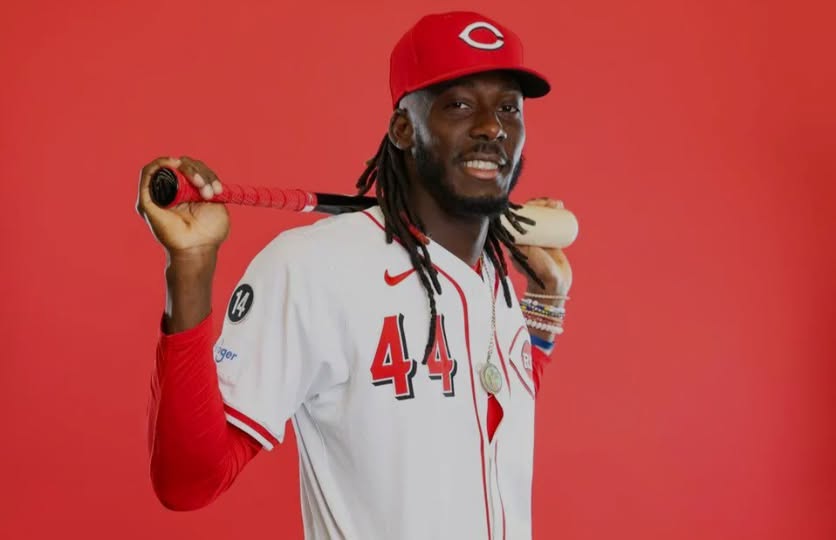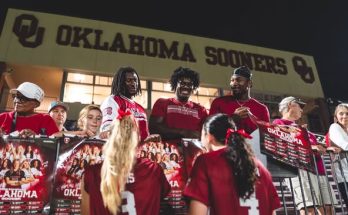Here’s an in-depth feature exploring why Elly De La Cruz might one day land a staggering $500 million-plus contract to play for the Yankees:
Elly De La Cruz is a once‑in‑a‑generation baseball phenom. At 23, he already combines elite power, game‑breaking speed, exceptional arm strength, and defensive versatility—all wrapped into a 6′5″ frame that looks more like an NBA forward than a shortstop. That level of athletic overload doesn’t just stand out—it redefines the game. A common refrain among the scouts and analysts is that he is baseball “create‑a‑player”—a human cheat code. Fox Sports dubbed him “MLB’s ‘create‑a‑player’” citing nights when he launches balls over 150 mph and robs would‑be home runs before burning down the bases with stolen bags .
In 2024, De La Cruz paired 25+ home runs with 67 steals—just the fifth player in modern history to pull off such a 20–60 season . He was voted an All‑Star, earned a Silver Slugger, and finished among the top shortstops in defensive metrics. By age‑22 he was already imposing his physicality on the game in a six‑fingered rulebook of power, speed, arm, and glove. His first 44 games included more steals than entire MLB teams had managed, and he became the first Reds player since Ichiro to log both four hits and four steals in a single game .
As scouts and front offices took note, speculation about a historic contract swirled. Industry execs now consider him among a select few—alongside Juan Soto and Gunnar Henderson—who might top $765 million at free agency . While Soto’s 15‑year, $765 million deal set the bar, multiple insiders believe De La Cruz’s eventual deal could eclipse that, potentially reaching or exceeding half‑a‑billion dollars .
His rise draws parallels to the mega‑contracts of the modern era. Vladimir Guerrero Jr. signed for $500 million recently, resetting the mid‑range market; De La Cruz has every profile of the next tier—premium youth, position (shortstop), elite defense, plus elite baserunning . At age 21 he began service, so when he hits free agency around 2029–2030 he’ll still be entering his athletic prime and command peak leverage .
Yet his path isn’t flawless. In the minors he struck out over 30%—a sign of potential plate discipline issues . But follow‑up season data shows improvement: increased walks, reduced strikeouts, adjustments to stance, and intentional plate approach . That transformation is a common evolution for explosive young hitters, and one fans and coaches are monitoring closely.
Reddit echoes the sense of awe:
“This guy is just unreal. … only player I can think of that was this dynamic right from the start is Ken Griffey Jr.” ,
“He’s not running, he’s teleporting. … blink, and he’s jumped ahead 90 ft.”
Even skeptics concede he’s learning: his eye at the plate is getting sharper, his strike zone more disciplined. And he’s still only 23—meaning the future impact is wide open .
Inside MLB, the buzz is real. ESPN’s Jeff Passan surveyed executives who named De La Cruz alongside Henderson as the most likely young stars to exceed Soto’s record‑setting pact . And Pitcher List highlights how his elite ceiling, combined with his position and age, places him squarely in the crosshairs of $700 million‑plus projections .
The Yankees, a franchise known for chasing elite position players before free agency, loom as a logical destination. They’ve consistently shown willingness to extend generational talents—see Aaron Judge, Gerrit Cole—and have been linked to De La Cruz in rumor mills . New York offers the bright lights, deep pockets, and immediate title contention he might gravitate toward.
Contract valuation models show that best player at premium position in baseball now costs between $140–160 million per year. Over 6 to 7 years, that’s a $840–1120 million range. But a conservative 5‑year deal at $100 million AAV already hits $500 million, a watershed figure MLB has skirted but not crossed—until now .
For the Yankees, a $500 million investment in De La Cruz checks every box: fills a premium position with youth and upside, fuels offense, adds defense and baserunning, plus brings novelty and marketability. That trio is rarer than big names alone. Add in his Dominican heritage—mirroring the Yankees’ successful Latino marketing traditions—and the case strengthens.
MLB infrastructure trends also favor high‑end shorter contracts now. Teams are trending toward 8–10 year pacts with full opt‑outs and player flex rather than 15 years locked in. It’s plausible the Yankees offer perhaps a 9‑year, $900 million deal—option structure tuned for risk—but a 5‑year, $500 million commitment is more conservative, still epochal, and places ownership on offense.
We should also weigh risk: shoulder and leg durability become concerns with elite athletes. Plate discipline may remain a work in progress. And MLB could implement new financial caps in upcoming CBAs that impact monster contracts . Still, De La Cruz’s combination of current performance and future track profile insulates against those risks more than most.
Let’s consider the timeline. De La Cruz will likely reach free agency after the 2029 season, aged 27–28. By then he could have put together 6–7 years of All‑Star caliber play, and the Yankees would have had three seasons to watch and build around him. That’s perfect launch point for a blockbuster QO or full‑market offer.
Even before FA, New York could extend him early at a premium—buying out arbitration years with an 6‑year, $225 million extension, then using opt‑out flexibility, setting the stage for future mega‑cash. Or they could wait, let arbitration inflate his value to $70–80 million per year, then offer him $160–170 million AAV in free agency—once again approaching or surpassing $500 million.
The mere possibility of De La Cruz in pinstripes at that scale sends shock waves across MLB. Smaller markets will struggle to match. Luxury tax debates will resurface. But the Yankees have led in embracing big contracts for cornerstone players—from Rodriguez to Cano to Judge—and this might be their next bold statement.
His own voice offers grounded perspective. In February 2025, when rumors of him being the first billion‑dollar player circulated, he told reporters:“I don’t pay attention to that. I just keep playing my game and living day to day—no looking ahead to the future. Billion dollars? Yeah, I don’t think about that.”
That on‑field maturity belies his youth. His focus remains simple: develop, perform, let the marketplace catch up. But forces are aligning—his athletic profile, market timing, team contexts, agency strategy, financial sea change—all pointing toward a future where De La Cruz could be the first player to sign for $500 million or more.
Baseball’s landscape is shifting. The precedent has moved from Trout/Ohtani ($400–600 million) to Soto ($765 million) to the next tier. And De La Cruz literally covers four quadrants: his bat, his speed, his arm, and his glove. Shortstops who run 200+ home runs and 200+ steals over a stretch are practically extinct today. He’s rewriting the model.
So could the Yankees sign him for $500 million? Yes. Should they? Absolutely, if he becomes the player they project. And will it define the next era of MLB contracts? Most likely. The question is not if—but when.
Elly De La Cruz is still only 23. With every game he plays, he refines the product and tightens the projection. The potential is there to break every financial ceiling. A half‑billion dollar contract was once science fiction—now, within reach. And if he keeps evolving, one day soon the Yankees—or another luxury‑market contender—will write that check, forever shifting the economics of baseball.



